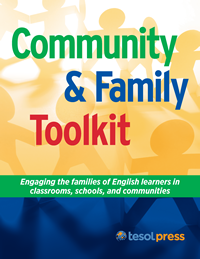|
 One of the greatest challenges in education today is increasing the attendance of parents and families at school events. When working with EL families, this challenge becomes even greater. Language barriers, work schedules, and lack of babysitting services all influence decisions to attend. Several successful strategies have been implemented in schools. These strategies have not only increased EL family attendance, but also deepened the partnerships between the school and the EL families. One of the greatest challenges in education today is increasing the attendance of parents and families at school events. When working with EL families, this challenge becomes even greater. Language barriers, work schedules, and lack of babysitting services all influence decisions to attend. Several successful strategies have been implemented in schools. These strategies have not only increased EL family attendance, but also deepened the partnerships between the school and the EL families.
Family Engagement
According to researchers Ferlazzo and Hammond (2009), there is a distinct difference between parent involvement and parent engagement. They define parent involvement as beginning with the school: “The ideas and energy come from the schools and government mandates. Schools try to ‘sell’ their ideas to parents” (p. 6). However, parents initiate engagement: “Ideas are elicited from parents by school staff in the context of developing trusting relationships….More parent energy drives the efforts” (p. 6).
When families engage, they are more invested in the school and in seeing the school and the community succeed.
|
 The TESOL Community & Family Toolkit, a resource for English language professionals to use at all levels to connect with families and build strong communities, is free to download. The TESOL Community & Family Toolkit, a resource for English language professionals to use at all levels to connect with families and build strong communities, is free to download.
|
Events and Tips to Increase Family Engagement
1. Celebrate Students’ Home Countries
Sponsor a “Country of the Month” bulletin board throughout the school. Have a visible school bulletin board highlight one country each month. If, for example, Vietnam is the country of the month, the board can introduce others to the location, language, popular foods, and holidays of Vietnam.
Then, each individual classroom could follow up with classroom bulletin boards highlighting that same country through potential readers, holidays, historical events, and so on. In a first-grade classroom, students could have a bulletin board on the dragon boat festival and design their own dragon boat. Change the bulletin boards monthly. Ensure that bulletin boards highlight the native countries of new students.
Alternatively (or in addition), have an area in your school where you display maps of all the areas where your EL families come from.
2. Provide Transportation
Provide transportation to school events, such as back-to-school night, assemblies, and parent-teacher conferences. Run the school bus route for school events, just as it is run in the morning and afternoon for school pick-up and drop-off.
3. Offer Babysitting Services
Offer babysitting services during school-sponsored events. Babysitters can be high school students.
- Arrange babysitters in various locations throughout the school, and allow parents to drop
children off in babysitting rooms.
- Consider offering babysitters community service hours.
4. Celebrate Multicultural Holidays
Ask students from the country of the holiday being celebrated to perform a song or dance. Students from the country highlighted could share stories related to that holiday with other children, or teach a song or dance.
5. Use Students’ Native Languages
Add welcome signs in your EL families’ first languages at the entrances to you school, and decorate the signs with flags from your EL families’ countries. When making school announcements, consider greeting (saying “good morning”) in a new language each week.
6. Host an International Luncheon or Dinner
This could be done at the classroom level, at the grade level, or with the entire school. If running the country of the month bulletin board, consider having an international luncheon or dinner after every four countries. Have foods focus on those countries highlighted.
Reference
Ferlazzo, L., & Hammond, L. (2009). Building parent engagement in schools. Denver, CO: Linworth.
This article is from the TESOL Community & Family Toolkit, available for free on the TESOL website. |